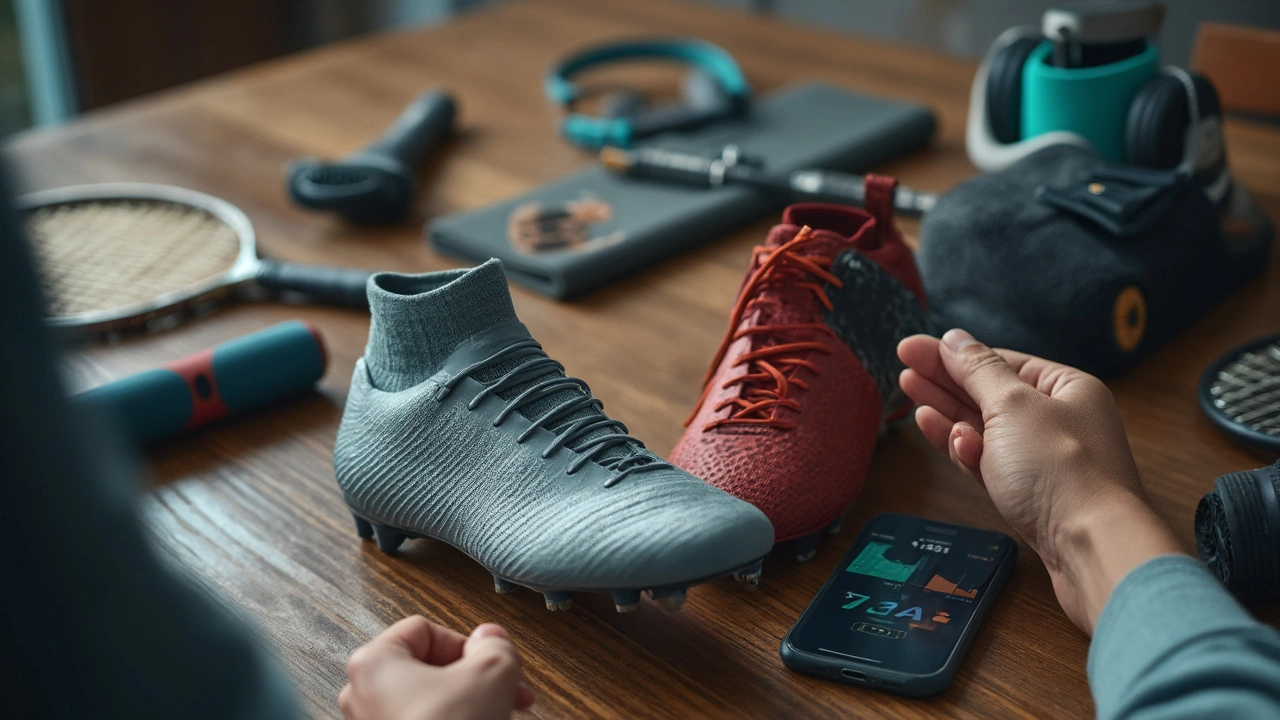Ever checked the price tag on new running shoes or a basic bike recently? Prices aren’t just going up for fun. The sports equipment market is massive—think hundreds of billions of dollars every year, and it's still growing like crazy. People are spending more on everything from smartwatches for tracking runs to simple soccer balls for weekend leagues. It isn’t just about athletes, either. Home workouts, casual games at the park, and even wearable tech have everyone opening their wallets for gear.
If you're wondering why a pair of branded basketball shoes can be as expensive as plane tickets, part of the story is this: huge demand, nonstop innovation, and fierce competition. The market is flooded with options—some legit, some knockoffs, but all of them fighting for your money. Whether you’re a parent buying equipment for the kids, a weekend warrior, or just looking for techy gym gadgets, understanding what drives the prices, which trends are on the rise, and where to find reliable gear can save you a lot of frustration—and cash. Let’s break down what’s really going on in this giant world of sports equipment.
- The Market by the Numbers
- What’s Behind the Growth?
- Biggest Players and Hottest Products
- Tech Shaking Up Sports Gear
- How Consumers Can Shop Smarter
- Future Trends to Watch
The Market by the Numbers
If you think the sports equipment world is just about shoes and balls, think bigger—way bigger. The current global sports equipment market size crossed $390 billion in 2024 and isn’t showing signs of slowing. Forecasts say that by the end of 2025, we're looking at about $420 billion worldwide. That's more than what most countries make in a year! The market’s been climbing at a steady 7% yearly, powered by both hardcore athletes and weekend hobbyists.
Asia’s leading the pack when it comes to sales growth, especially in China, India, and Southeast Asia. North America and Europe are still top spenders, thanks to strong consumer brands and deep sports culture. Online sales are exploding—most folks now buy rackets, fitness trackers, and apparel with just a few taps on their phone.
"The digital fitness boom and demand for performance-enhancing gear have supercharged this industry beyond past predictions," says a recent report by Grand View Research.
Just to give you a sense of scale, here’s how things stack up by region and product type:
| Region | 2024 Market Size (USD Billion) | Expected Growth (2024-2025) |
|---|---|---|
| North America | 112 | 5% |
| Europe | 98 | 4.5% |
| Asia-Pacific | 140 | 9% |
| Rest of World | 40 | 4% |
| Category | 2024 Sales (USD Billion) |
|---|---|
| Footwear | 130 |
| Apparel | 95 |
| Fitness Equipment | 44 |
| Team Sports Gear | 38 |
| Other (e.g., racquets, accessories) | 83 |
There’s no sign this wave is crashing soon. People spend more on fitness and gear not just for sports, but for lifestyle. With tech upgrades and new products showing up all the time, expect these numbers to keep climbing. For anyone eyeing a side hustle or thinking about opening a sports store, this market has more room than a football field.
What’s Behind the Growth?
Think the sports equipment market is just about pro athletes and their fancy endorsements? Not even close. The real engine behind this industry’s insane growth is regular people. More people than ever are joining gyms, signing up for marathons, or just buying yoga mats for home workouts. In 2024, almost 1 in 4 adults worldwide said they were working out more now than they did before the pandemic. That’s turned fitness into big business—and gear sales skyrocketed at the same time.
Here’s what’s really driving the boom:
- sports equipment market size keeps expanding because millions got hooked on staying active during lockdowns and stuck with it.
- Social media and fitness influencers aren’t just selling workout plans; they’re moving mountains of gear. A single trending video can make a resistance band or a smart water bottle sell out overnight.
- Tech has worked its way into almost everything—from smart shoes that track running style to connected treadmills you can use to race against your best friend halfway across the world.
- Schools, youth sports clubs, and community centers are investing more in gear, especially as studies link physical activity to better mental health in kids.
- People are finally paying serious attention to their health, so they’re spending on home fitness setups, outdoor gear, and even simple things like jump ropes and foam rollers.
Check out the real numbers behind this growth:
| Year | Global Sports Equipment Revenue (USD) |
|---|---|
| 2020 | $340 billion |
| 2022 | $380 billion |
| 2024 | $417 billion |
| 2025 (projected) | $440 billion |
Every year sees new brands trying to steal a piece of that pie. It’s not just about sales in the U.S. or Europe, either—as incomes rise in countries like India, Brazil, and China, more people are splurging on gear for cricket, badminton, cycling, and just hitting the gym. The sports equipment industry is growing on every continent, making it feel like the next big thing is always just around the corner.
Biggest Players and Hottest Products
If you follow the sports equipment market size story, you know a few heavyweights run the show. Nike, Adidas, and Under Armour pretty much rule the global scene. In 2024, Nike alone pulled in over $50 billion in revenue. That’s a lot of sneakers, balls, and gym bags. Adidas isn’t far behind, especially strong in Europe and soccer gear. Then you’ve got Under Armour, known for making workout clothes that actually feel good—plus they’re always rolling out something new in shoes and accessories.
But it's not just these giants dominating the shelves. Brands like Puma and ASICS have carved out huge slices, especially among runners and soccer players. Wilson and Spalding own the courts—so if you’re grabbing a basketball or tennis racket, odds are one of their logos is on it. Meanwhile, Decathlon is quietly taking over with its massive stores and value-for-money equipment, especially in Europe and Asia.
Let’s talk hottest products, because the trends have shifted fast. Smart fitness trackers, such as those from Garmin or Apple, are flying off shelves. Home gym gear—especially adjustable dumbbells, resistance bands, and compact treadmills—became huge after the pandemic and the demand hasn’t died down. And if you’re a sneakerhead, you already know: running shoes with advanced foam tech (think Nike Air Zoom or Adidas Ultraboost) are big sellers, as are all those limited-edition drops that disappear in minutes.
Want gear that’s always in demand? Here’s what’s topping most people’s shopping lists right now:
- Smartwatches and fitness bands with GPS and heart rate tracking
- Hybrid or electric bikes for city riders and commuters
- Yoga mats and accessories—still booming after lockdowns
- High-performance running shoes, especially eco-friendly ones
- Portable recovery gear—massage guns, foam rollers, and cold therapy packs
One more tip: Knockoffs are everywhere, especially online. If you want genuine, quality gear from these big names, stick to official retailers or trusted sports shops. If a deal looks too good to be true, it probably is.

Tech Shaking Up Sports Gear
Technology is changing the way we play, train, and even buy our sports stuff. It’s not just about having the latest pair of sneakers anymore—it’s about having gear that connects, tracks, and helps you improve. Here’s what’s really shaking up the world of sports equipment right now.
Wearables are everywhere. Think smartwatches, fitness trackers, and even smart shoes that connect to your phone. Fitbit and Apple Watch lead the pack, letting you track every step, calorie, and heartbeat. Pro athletes and weekend joggers use wearables to check progress and stay motivated. Sensors built into socks, shirts, or even sports bras can give live stats, which some trainers say actually helps boost performance.
Then there’s connected equipment that talks to your apps. Smart tennis rackets record the speed and angle of your hits. Connected soccer balls send data straight to your phone so you can watch how you kick in real time. Peloton bikes and smart treadmills turn a living room into a gym with live classes and leaderboards. It sounds futuristic, but this is today’s reality—and it’s big business.
| Product | How It’s Smart | Avg. Price (USD) |
|---|---|---|
| Apple Watch Series 9 | Tracks fitness, heart rate, sleep, ECG | $399 |
| Wilson X Connected Basketball | Records shots, tracks makes/misses | $200 |
| Nike Adapt BB Shoes | Self-laces, links to your phone | $350 |
| Peloton Bike | Live classes, stats tracking, leaderboards | $1,445 |
| Garmin Forerunner 265 | GPS runs, heart rate, music | $450 |
The surge in smart gear is a huge reason why the sports equipment market size keeps climbing. According to Statista, global sports tech revenues passed $20 billion in 2024 and are still growing fast. More sports brands are jumping on the trend, launching connected products for almost every sport—football, basketball, golf, even yoga mats that correct your poses.
For shoppers, the upside is obvious: you get instant feedback and can level up faster, whether you play solo or with friends. The only tip here—read reviews and check app support before buying, since some devices lose features if the brand drops their app. Look for gear with replaceable batteries or open app access to avoid getting stuck with dead tech. Tech in sports gear is only getting smarter, so keeping an eye on the latest releases is worth your time—even if you’re just getting started.
How Consumers Can Shop Smarter
Scoring the best sports gear is more than just hunting for a sale—it’s about knowing what, when, and where to buy. Shoppers today have a ton of options, but not every deal is a win. Here’s how to separate the good stuff from the junk and keep your wallet happy while getting the gear you actually need.
Brand reputation still matters a lot. According to a 2024 Statista report, over 65% of buyers said they trust major brands for reliability, especially in products like helmets, shoes, and tech gadgets. But that doesn’t mean small brands are out. New sports startups often bring better prices and creative features—just check online reviews and user communities before you buy.
Fake sports gear is a huge problem. The sports equipment market size is so big, counterfeits have become a multi-billion dollar headache. A detailed review in 2023 found that nearly 1 in 4 items sold online under major brands were knockoffs. Always buy from official websites or legit retailers, especially with high-demand products—those too-good-to-be-true Instagram deals usually are.
| Item | Official Store | Discount Retailer | Price Gap (%) |
|---|---|---|---|
| Running Shoes | $140 | $95 | 32% |
| Basketball | $60 | $38 | 37% |
| Fitness Tracker | $180 | $119 | 34% |
The table shows you can save big buying from discount spots, but there’s a risk of getting last year’s model or less warranty support. For big-ticket items, balance the savings with the peace of mind of buying from an official source.
- Compare prices online and offline—sometimes local shops will match online deals if you ask.
- Set price alerts for gear on your wish list. Sites like CamelCamelCamel even work for Amazon deals.
- Watch for seasonal sales—May (around Memorial Day), November (Black Friday), and January (New Year’s fitness craze) are golden times to buy equipment.
- Always check for student, military, or loyalty discounts. Brands rarely advertise these front and center, but they often work at checkout.
- Use community forums or Reddit threads to get honest feedback on whether that hyped-up gadget is worth it.
Don’t forget to look at warranty and return policies, too. If a retailer makes it hard to return something, that’s a red flag—especially with expensive tech or custom-fit gear. Being a smart shopper in this huge industry means doing a little homework, but the payoff is better equipment and fewer regrets.
Future Trends to Watch
The sports equipment industry isn’t just keeping up—it’s sprinting ahead with big changes you’ll actually notice soon. The big thing? Smart tech everywhere. Fitness trackers and connected home workout gear are blowing up. In 2024, smart fitness equipment made up almost 17% of all sports gear sales worldwide, and that number keeps rising each quarter. People want instant feedback and real results without leaving the house.
Sustainability is pushing even the biggest brands to change. Adidas now makes some sneakers out of recycled ocean plastic, and Wilson has a basketball that uses less water and energy to make. It’s not just a “nice-to-have”—consumers are hunting for greener options and are willing to pay a little more for products with a smaller footprint. Expect recycled materials, vegan leathers, and even bio-based foams to become normal.
Customization is another trend picking up speed—fast. More shoppers want gear that shows off their personal style or fits their body better. Companies are responding big-time. For example, Nike’s custom shoe builder lets buyers tweak colors, sizes, even materials, and smaller brands that 3D-print mouthguards or shin pads are getting popular for people who want that perfect fit.
- Smart gear and wearables for real-time performance tracking
- Sustainable materials like recycled polyester and ocean plastics
- 3D printing for quick, made-to-order equipment
- Augmented reality (AR) shopping experiences
- Products focused on injury prevention and recovery
One more thing stealing the spotlight is women’s sports gear. It’s the fastest-growing part of the sports equipment market size right now. Gear built for women—think running shoes with different heel-to-toe drops, or rackets sized for smaller hands—is everywhere. Companies see that women’s sports aren’t just mainstream, but a huge business all on their own.
| Trend | 2024 Market Share (%) | Expected Growth by 2028 (%) |
|---|---|---|
| Smart Fitness Equipment | 17 | 29 |
| Sustainable Products | 9 | 18 |
| Custom-made Gear | 6 | 15 |
| Women’s Sports Equipment | 10 | 22 |
For anyone thinking about their next purchase—or even starting a business in this space—keep these trends on your radar. The gear you use or buy this year could look totally different in just a couple years, and that’s not slowing down anytime soon.






